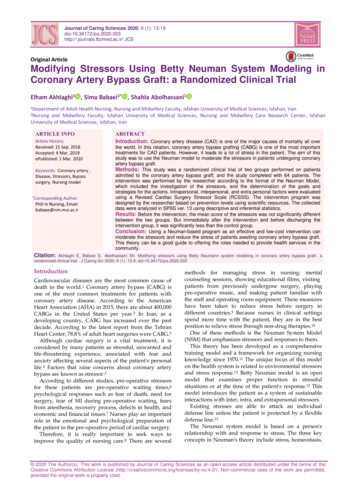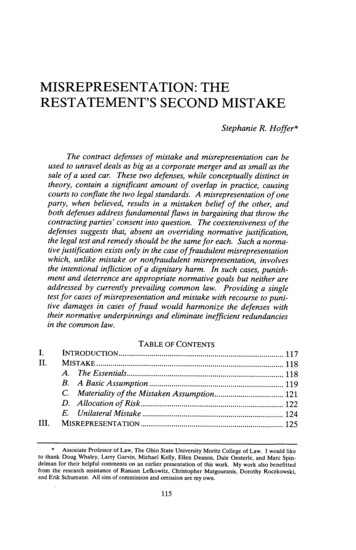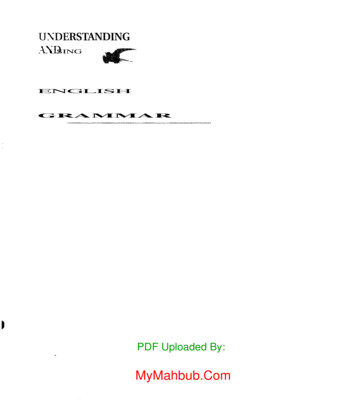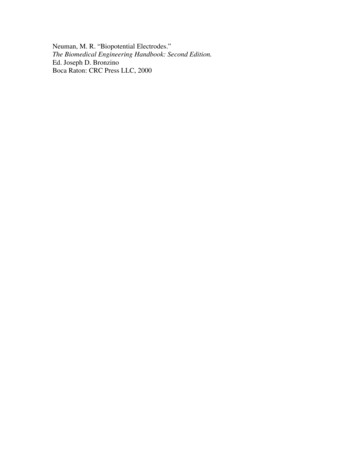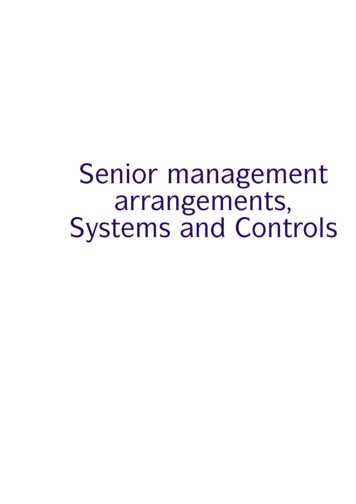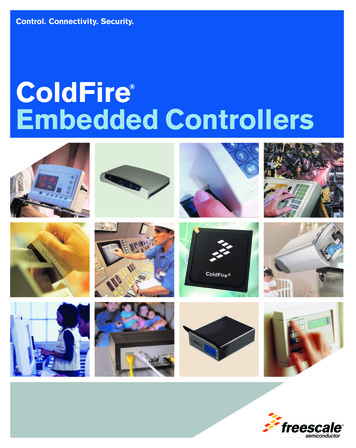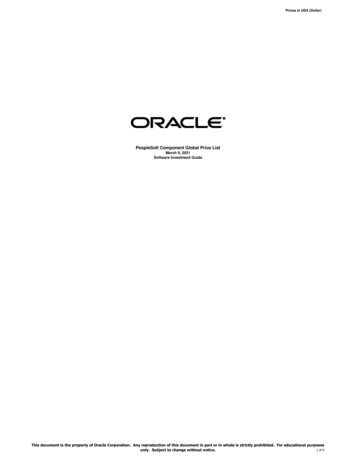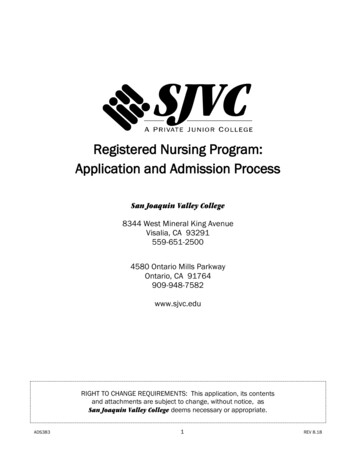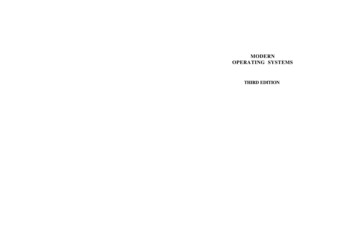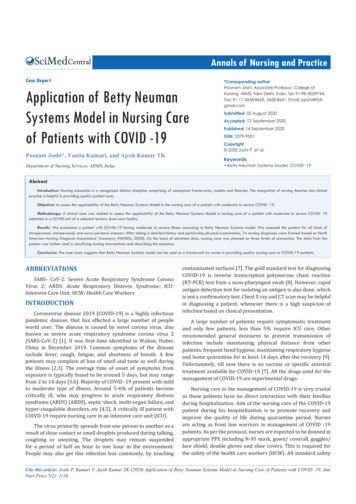
Transcription
Annals of Nursing and PracticeCentral Bringing Excellence in Open AccessCase ReportApplication of Betty NeumanSystems Model in Nursing Careof Patients with COVID -19Poonam Joshi*, Vanita Kumari, and Ajesh Kumar TKDepartment of Nursing Services, AIIMS, India*Corresponding authorPoonam Joshi, Associate Professor, College ofNursing, AIIMS, New Delhi, India. Tel: 91-9818039744;Fax: 91-11-2658-8663, 2658-8641; Email: pjoshi495@gmail.comSubmitted: 02 August 2020Accepted: 12 September 2020Published: 14 September 2020ISSN: 2379-9501Copyright 2020 Joshi P, et al.Keywords Betty Neuman Systems Model; COVID -19AbstractIntroduction: Nursing education is a recognized distinct discipline comprising of conceptual frameworks, models and theories. The integration of nursing theories into clinicalpractice is helpful in providing quality patient care.Objective: to assess the applicability of the Betty Neuman Systems Model in the nursing care of a patient with moderate to severe COVID- 19.Methodology: A clinical case was studied to assess the applicability of the Betty Neuman Systems Model in nursing care of a patient with moderate to severe COVID- 19admitted in a COVID unit of a selected tertiary level care facility.Results: We evaluated a patient with COVID-19 having moderate to severe illness according to Betty Neuman Systems model. We assessed the patient for all kinds ofintrapersonal, interpersonal, and extra-personal stressors. After taking a detailed history and performing physical examination, 14 nursing diagnoses were framed based on NorthAmerican Nursing Diagnosis Associations’ Taxonomy (NANDA, 2020). On the basis of obtained data, nursing care was planned on three levels of prevention. The data from thepatient was further used in classifying nursing interventions and describing the outcomes.Conclusion: The case study suggests that Betty Neuman Systems model can be used as a framework by nurses in providing quality nursing care to COVID-19 patients.ABBREVIATIONSSARS- CoV-2: Severe Acute Respiratory Syndrome CoronaVirus 2; ARDS: Acute Respiratory Distress Syndrome; ICU:Intensive Care Unit; HCW: Health Care WorkersINTRODUCTIONCoronavirus disease 2019 (COVID-19) is a highly infectiouspandemic disease, that has affected a large number of peopleworld over. The disease is caused by novel corona virus, alsoknown as severe acute respiratory syndrome corona virus 2(SARS-CoV-2) [1]. It was first time identified in Wuhan, Hubei,China in December 2019. Common symptoms of the diseaseinclude fever, cough, fatigue, and shortness of breath. A fewpatients may complain of loss of smell and taste as well duringthe illness [2,3]. The average time of onset of symptoms fromexposure is typically found to be around 5 days, but may rangefrom 2 to 14 days [3,6]. Majority of COVID -19 present with mildto moderate type of illness. Around 5-6% of patients becomecritically ill, who may progress to acute respiratory distresssyndrome (ARDS) (ARDS), septic shock, multi-organ failure, andhyper-coagulable disorders, etc [4,5]. A critically ill patient withCOIVD-19 require nursing care in an intensive care unit (ICU).The virus primarily spreads from one person to another as aresult of close contact or small droplets produced during talking,coughing or sneezing. The droplets may remain suspendedfor a period of half an hour to one hour in the environment.People may also get this infection less commonly, by touchingcontaminated surfaces [7]. The gold standard test for diagnosingCOVID-19 is reverse transcription polymerase chain reaction(RT-PCR) test from a naso-pharyngeal swab [8]. However, rapidantigen detection test for isolating an antigen is also done, whichis not a confirmatory test. Chest X ray and CT scan may be helpfulin diagnosing a patient, whenever there is a high suspicion ofinfection based on clinical presentation.A large number of patients require symptomatic treatmentand only few patients, less than 5% require ICU care. Otherrecommended general measures to prevent transmission ofinfection include maintaining physical distance from otherpatients, frequent hand hygiene, maintaining respiratory hygieneand home quarantine for at least 14 days after the recovery [9].Unfortunately, till now there is no vaccine or specific antiviraltreatment available for COVID-19 [7]. All the drugs used for themanagement of COVID-19 are experimental drugs.Nursing care in the management of COVID-19 is very crucialas these patients have no direct interaction with their familiesduring hospitalization. Aim of the nursing care of the COVID-19patient during his hospitalization is to promote recovery andimprove the quality of life during quarantine period. Nursesare acting as front line warriors in management of COVID -19patients. As per the protocol, nurses are expected to be donned inappropriate PPE including N-95 mask, gown/ coverall, goggles/face shield, double gloves and shoe covers. This is required forthe safety of the health care workers (HCW). All standard safetyCite this article: Joshi P, Kumari V, Ajesh Kumar TK (2020) Application of Betty Neuman Systems Model in Nursing Care of Patients with COVID -19. AnnNurs Pract 7(2): 1116.
Joshi P, et al. (2020)Centralprecautions were observed by the nurses in our unit, while takingcare of COVID -19 patients as per the institute protocol.Many nursing theories have made a significant contributionin expanding the body of nursing knowledge in nursingpractice; which makes the modern nursing more significant andconsequential to promote nursing as an ordered profession.Nursing theories describe and relate different aspects of practiceand give as a framework for systemizing the nursing practice[12]. According to Neuman Systems model, nursing is a uniqueprofession that brings stability in the client system. Accordingto Betty Neuman, nursing is an “action which assist individuals,families and groups to maintain a maximum level of wellness,and the primary aim of nursing is to provide stability to thepatient/client system, through nursing interventions in order toreduce stressors’’ [12]. This model emphasises on three level ofprevention (Primary, Secondary, and Tertiary). The preventionfocuses on keeping stressors and the stress responses of thepatient from having a detrimental effect on his body. This theoryhas been tried out in some clinical conditions like stroke, andmultiple sclerosis [13-14]. We decided to study applicationof Betty Neuman Systems model in a COVID-19 patient, in thepresent pandemic situation.CLINICAL CASE REPORTMr ABC, a 47 year old male was admitted in COIVD -19 wardresident of Gwalior, Madhya Pradesh, India was admitted thoughemergency department after being referred from a privatehospital. The presenting chief complaints of the patient werefever for 9 days associated with chills and rigors and shortnessof breath for 6 days. There was no history of orthopnea orparoxysmal nocturnal dyspnea [PND] or cough or hemoptysis, butcomplained of some epigastric discomfort. He also complained ofloss of appetite and wheezing. However there was documentedweight loss.On examination Conscious, E4V5M6, HR 79/min, BP 131/87mm Hg, RR 18/min, SPO2 95% on 6-7 liters/ minThere was no past history of Hypertension, Coronary ArteryDisease, Diabetes Mellitus, Jaundice or Tuberculosis or anyprevious surgery. He was a nonsmoker and consuming smokelesstobacco for 30 years and alcohol for 3 years.INVESTIGATIONSRapid antigen test done on the patient was negative, butReverse Transcription Polymerase Chain Reaction (RT-PCR)test was positive. Chest x ray revealed bilateral (B/L) LowerLobes infection. High contrast Computerized Tomography(HCCT) revealed B/L consolidation with ground glass densityand enlarged lymph nodes and mild hepatomegaly. FocusedAssessment with Sonography for Trauma (FAST) scan showedB/L minimal pleural effusion, Inferior Vena Cava (IVC) 50%collapsibility and left ventricle showing good contractility. ABGreport of the patient showed pH 7.53, PO2 59 mmHg, PCO2 34.6mmHg HCO3- 28.6mEq/L, and moderately raised Serum Lactate(2.1mmol/L) level suggestive of ongoing organ dysfunction andsepsis. Clinical blood chemistry showed neutrophilia (75.4%)and lymphopenia (17.3%) and low Serum Potassium level (2.9mEq/L).Ann Nurs Pract 7(2): 1116 (2020)TREATMENTHe was started on oxygen therapy with high frequencynasal (HFNC) cannula @7 L/ min. The medical treatment planincluded Inj Piptaz (Piperacillin and Tazobactam) 4.5 gm IV TDS,Inj Azithromycin 500 mg BD, Inj Levofloxacillin 750 mg IV OD,Inj Pantoprazol 40 mg OD, Inj Paracetamol (PCM) 1 gm SOS andIV Lactated Ringer fluid @ 100ml/hr with 2 mEq/100 ml KCL.Patient was allowed to take oral fluids only for the administrationof oral drugs. Oral medications such as Tab Vitamin C 500mgTDS, Tab Hydroxychloroquine 400 mg BD followed by 400 mgOD, Tab Zinc 50 mg BD were also started. IV fluid normal saline @100mL/ hr over 24 hours was started. He was voiding self.Comprehensive nursing care was provided by a team ofnursing personnel posted in COVID unit. They were donned inappropriate personal protective equipment (PPE). A primarynurse was made responsible for identifying and developingthe nursing care plan. Patient was also provided with a triplelayer surgical face mask to contain the droplets and respiratorysecretions. Stressors and reactions of the patient were identified(Table 1). Nursing care plan was developed which includednursing diagnoses, nursing goals, nursing interventions andnursing outcomes. Nursing care was provided to the patientaccording to the developed nursing care plan.DISCUSSIONNursing care was given to the patient as per the identifiedstressors and his reaction to the stressors. He showed signs ofimprovement and was successfully discharged from the hospitalwith the advice of 14 days home quarantine. Results of ourclinical case study are similar to the previous case studies doneon multiple sclerosis and stroke patients. [13,14].In the present clinical case study 14 nursing diagnoses wereframed considering intra-personal, interpersonal and extrapersonal stressors and patient’s reactions to those stressors.Table 1: Stressors and reactions of Mr. ABC to COVID-19.StressorReactionDifficulty in breathing and wheezingFeverPhysiologicalEpigastric discomfortLoss of appetiteInability to sleepPowerlessness and having weakness. Anxiety about3 children, who were still studying and about theirfuture.Psychological Concerned about his wife at home, what will happenif something happens to him?Did not share information about his sickness with hisclose friends and relatives47 year middle aged, studied up to middle level andDevelopmentalan active member of the familyHad few relatives and close friendsSocio-cultural Had not disclosed his status to all the relatives andfamily friendsFollowed Hindu religion, He had faith on Hindu idolSpiritual(Hanumanji), who will come for his support. Prayingto the GOD while being in the hospital2/5
Joshi P, et al. (2020)CentralTable 2: Nursing Management of the patient with COVID-19.S.N.Nursing DiagnosisNursing GoalLevel ofPreventionNursing InterventionNursing OutcomePhysiological1Altered breathingpatternsTo ease the workof breathing andmaintain SPO2 withinnormal range2.Altered bodytemperatureTo maintain bodytemperature with innormal range3At risk forhemodynamicinstability4Impairednutritional statusSecondary andtertiarySecondaryTo maintain vitalparameters within age Primary andappropriate normalSecondaryrangeTo improve patient’snutritionSecondary5Assisting the patient inActivity intolerance carrying out activities Secondaryof daily living6Disturbed sleep78Restricting fluids toPotential to develop 2/3rd of maintenancefluid overloadfluidand electrolyteMaintainingimbalancenormal lactate andelectrolytes levelsTo protect the patientPotential to developfrom developingadded infectionssuper-added infectionsPsychological9Providing rest andimproving his qualityof sleepPsychologicaldistressIn terms of anxietyand stress relatedto family anddisease courseAnn Nurs Pract 7(2): 1116 (2020)SecondaryPrimary &SecondaryPrimary &SecondaryHelping patient toreduce his anxiety andSecondarystress related to familymembers-Assessed respiratory rate and pattern-Provided Prop up position-Initiated oxygen therapy using HFNCcannula @ 7 L/ min-Promoted humidification-Monitored SpO2-Encouraged coughing and deep breathingexercises while observing all respiratoryprecautions- Provided frequent mouth care-Monitored temperature of the patientevery 4 hourly-Administered antipyretic Inj Paracetamol1gm IV SOS-Given tepid sponging to reduce the bodytemperature-Monitored vital signs like heart rate (HR)and blood pressure (BP)-Recorded intake output and laboratoryreports-Provided food in a quiet environment-Given him easily digestible soft food, andsmall frequent meals-Offered warm freshly cooked foodaccording to his likes and dislikes-Administered Vitamin C and ZincSulphate to improve the immunity of thepatient-Assisted patient in performing hisactivities of daily living on the bed itself-Helped him to walk in his unit as per histolerance-Provided quiet environment for sleepwith minimum disturbance-Scheduled drug administration timing inorder to minimize disturbances-Started IV fluids @ 100mL/ Hr in 24hours-Monitored serum electrolytes and lactatelevelsAdministered KCL 20 mEq/ L-Administered antibiotics as prescribedEncouraged patient to observe handhygiene and respiratory hygieneHypoxemia got corrected,patient was maintainingsaturation 95% with FiO2of 60% and gradually beweaned off oxygenPatient’s temperature wasmaintained within normalrangeVital parameters weremaintained within ageappropriate normal rangePatient was trying toincrease his food intakePatient was able to performactivities with minimalassistanceQuality and duration ofsleep improvedNo signs of fluid overload.Electrolyte and lactateswere maintained withinnormal rangePatient did not develop anyadded infections-Calmed him down during acuterespiratory distress-Made oneself available to meet the needsof the patient-Kept a call bell system for calling nursefor helpHis anxiety got relieved-Assisted him in learning relaxationand communicated with histechniques and keeping his negativefamily telephonicallythoughts awayEncourage patient to express his feelings-Encouraged him to talk to his family afterstabilization of his conditionmembers through video call onstabilization of his condition3/5
Joshi P, et al. (2020)Central10Fear of unknownand being awayfrom his nativeplaceAssisting patient tofeel comfortable in ahospital away from his Secondaryfamily and in a city notmuch known to him-Reassured him.-Made oneself available to meet all hisphysiological needs-Helped him in connecting with his familymembers telephonicallyHis fear of unknown wasreduced to some extent-Social isolation dueto disease condition-Stigma attached toCOVID-19Providing patientsupport and helpinghim to get rid oflonelinessSecondary-Counseled him to understand theetiology of disease-Encouraged family members to talk tothe patient through video call-Prepared him to disclose his status to hisclose friendsPatient felt relaxed afterhaving talked to his familymembers and friendsTertiary-Counseled patient to change his life style-Performed yoga and breathing exercises-Abstain from alcohol and smokelesstobacco after his recoveryWill be able to abstain fromalcohol and smokelesstobaccoSecondary andtertiary-Provided health education to the patientabout the disease transmission and waysto prevent the transmission of infectionPatient observed allprecautionsSecondary-Assisted patient in reciting HanumanChalisa (a Hindu devotional hymn (stotra)addressed to Lord Hanuman).-Assisted him in offering prayers andarrange a spiritual person for thecounselingPatient appearedcomfortable and relaxedafter offering 14.Counselling him toAt risk forgive up alcohol anddeveloping cardiosmokeless tobaccovascular respiratoryupon his completeand oral problemsrecoveryKnowledge deficitrelated toEducating patientunfamiliarityabout the diseasewith diseaseCOVID-19transmissioninformationSpiritual distressInvolve patient inreligious activitiesNursing interventions were carried out as per the nursing careplan.pneumonia in Wuhan, China: a descriptive study. The Lancet. 2020;395: 507-513.Application of Neuman’s systems model in COVID-19 patienthelped us in identifying various intrapersonal, interpersonal, andextra-personal stressors present in the patient with COVID-19.Nursing interventions were planned and delivered, consideringall three levels of prevention of care (Table 1,2). The application ofthis theory in the present clinical study revealed the effectivenessof the primary, secondary and tertiary prevention interventions.The model could be used for solving the problems of patient withCOVID-19 by controlling the effect of all stressors on the client’ssystem.2. Hui D, I Azhar E, Madani T, Ntoumi F, Kock R, Dar O, et al. The continuing2019-nCoV epidemic threat of novel coronaviruses to global health —The latest 2019 novel coronavirus outbreak in Wuhan, China. Int Jinfect Dis. 2020; 91: 264-266.Betty Neuman Systems model can be used as a framework bynurses in providing quality nursing care to COVID-19 patients.The model is effective in solving the nursing problems of patientwith COVID-19, by controlling the effect of all stressors on thepatient/client’s system.5. Cascella M, Rajnik M, Cuomo A, Dulebohn SC, Di Napoli R. “Features,Evaluation and Treatment Coronavirus (COVID-19)”. Stat Pearls.Treasure Island (FL): StatPearls. 2020: 32150360.CONCLUSION3. Grant M, Geoghegan L, Arbyn M, Mohammed Z, McGuinness L, ClarkeE, et al. The Prevalence of Symptoms in 24,410 Adults Infected by theNovel Coronavirus (SARS-CoV-2; COVID-19): A Systematic Reviewand Meta-Analysis of 148 Studies from 9 Countries. SSRN ElectronicJournal. PLoS ONE. 2020; 15: e0234765.4. Murthy S, Gomersall C, Fowler R. Care for Critically Ill Patients WithCOVID-19. The Journal of the American Medical Association. 2020;323: 1499.ACKNOWLEDGEMENTS6. Velavan T, Meyer C. The COVID‐19 epidemic. Tropical Medicine &International Health. 2020; 25: 278-280.Authors would like to thank Mahesh Kushwaha, who wasadmitted with COVID-19 disease in our COVID unit, and allowedus to use his case history for preparing the clinical case study.8. Centre for disease control and prevention. Interim Guidelines forCollecting, Handling, and Testing Clinical Specimens from Persons forCoronavirus Disease 2019 (COVID-19). 2020; 1-5.REFERENCES1. Chen N, Zhou M, Dong X, Qu J, Gong F, Han Y, et al. Epidemiologicaland clinical characteristics of 99 cases of 2019 novel coronavirusAnn Nurs Pract 7(2): 1116 (2020)7. Bourouiba L. Turbulent Gas Clouds and Respiratory PathogenEmissions. JAMA Insights. 2020.9. Feng S, Shen C, Xia N, Song W, Fan M, Cowling B. Rational use of facemasks in the COVID-19 pandemic. The Lancet Respiratory Medicine.2020; 8: 434-436.4/5
Central10. Knight J. The Betty Neuman Systems Model applied to practice: aclient with multiple sclerosis. Journal of Advanced Nursing. 1990; 15:447-455.11. George JB. Nursing Theories. The base for professional nursingpractice. 6th ed. Pearson. 2010; 14.12. Smith MC, Parker ME. Nursing theories and nursing practice. 4th edn.Philadelphia.Joshi P, et al. (2020)13. Sultan B. Application of Betty Neuman Theory in Care of StrokePatient. Annals of Nursing and Practice. 2018; 5: 1092.14. Ahmadi Z, Sadeghi T. Application of the Betty Neuman systems modelin the nursing care of patients/clients with multiple sclerosis. MultipleSclerosis Journal – Experimental, Translational and Clinical. 2017; 3:205521731772679.15. Vera M. Nursing Diagnosis: Everything You Need to Know. Nurseslabs.2019.Cite this articleJoshi P, Kumari V, Ajesh Kumar TK (2020) Application of Betty Neuman Systems Model in Nursing Care of Patients with COVID -19. Ann Nurs Pract 7(2): 1116.Ann Nurs Pract 7(2): 1116 (2020)5/5
the nursing care plan. Patient was also provided with a triple layer surgical face mask to contain the droplets and respiratory secretions. Stressors and reactions of the patient were identified (Table 1). Nursing care plan was developed which included nursing diagnoses, nursing goals, nursing interventions and nursing outcomes.
